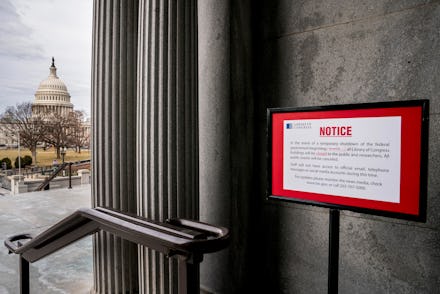The US government shutdown, by the numbers

The U.S. government shutdown is slated to come to an end on Monday, as lawmakers in the Senate voted in favor of a short-term funding deal that would fund the government through Feb. 8.
The bipartisan agreement includes a six-year extension for the Children’s Health Insurance Program, but does not include the immigration protections that Democrats have been pushing for. Instead, Democratic senators received an agreement from Senate Majority Leader Mitch McConnell that Deferred Action for Childhood Arrivals protections would be put up for a vote before the program expires on March 5.
The Senate deal comes as the three-day shutdown extended into the work week, which intensified its effects as federal employees were furloughed and many government services came to a halt. Here are the numbers behind the brief shutdown — and what could soon return, if Congress hasn’t reached a new deal by the February deadline.
850,000
Approximately 850,000 federal employees were furloughed during the most recent government shutdown in 2013, according to an Office of Management and Budget report compiled by the Obama administration. The combined total of the furloughed employees’ lost wages during the 16-day shutdown was approximately $2.5 billion.
On Monday, multiple government agencies were again forced to furlough many of their employees. According to the New York Times, the Departments of Housing and Urban Development, Education, Commerce, Labor and the Interior and the Environmental Protection Agency all furloughed between 80 and 96% of their employees. Other agencies with a greater share of employees serving an essential function — such as the Departments of Homeland Security, Justice and Veterans Affairs — retained most of their staff during the three-day shutdown.
81
A total of 81 senators voted for the continuing resolution on Monday, ending the shutdown. Eighteen Senators voted against the measure, including prominent Democratic and progressive Sens. Cory Booker, Bernie Sanders, Kamala Harris, Elizabeth Warren and Kirsten Gillibrand — all of whom have been discussed as potential 2020 presidential contenders.
17
There are 17 days before the current continuing resolution re-opening the government expires on Feb. 8.
52
Fifty-two percent of Americans blamed President Donald Trump and congressional Republicans for the shutdown, according to a poll conducted by Public Policy Polling. Of those polled, 43% thought congressional Democrats were at fault.
800,000
Approximately 800,000 DACA recipients will be affected if Democrats aren’t able to secure protections for the program in the immigration vote promised as part of the Senate deal.
$65,000
The New York state government spent $65,000 on Monday to keep the Statue of Liberty and Ellis Island open during the shutdown. The landmarks re-opened on Monday after being shuttered over the weekend.
60,000
An average of 60,000 Social Security applications are received each day. These could not be processed during the previous shutdown, according to the 2013 Office of Management and Budget report.
139
Out of 417 sites managed by the Department of the Interior, approximately 139 national parks sites closed during this shutdown, according to the National Parks Conservation Association. According to the 2013 OMB report, the agency lost $450,000 in revenue per day during the 2013 shutdown.
19
There have been 19 government shutdowns in some form since 1976.
$6.5 billion
The estimated weekly cost to the U.S. economic output during a government shutdown is $6.5 billion, according to a Standard & Poor’s analysis cited by the New York Times.